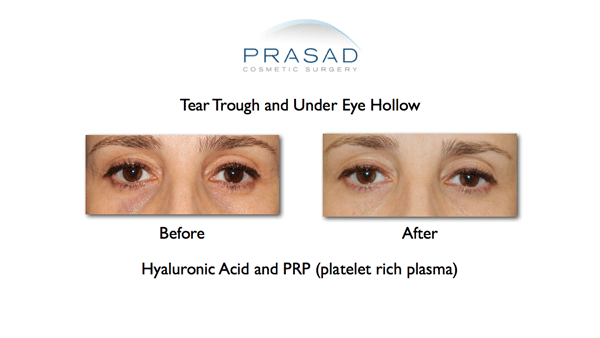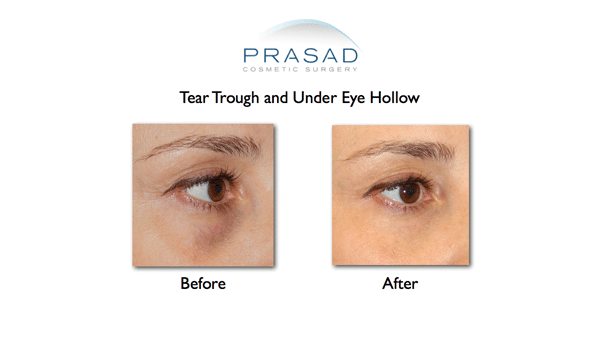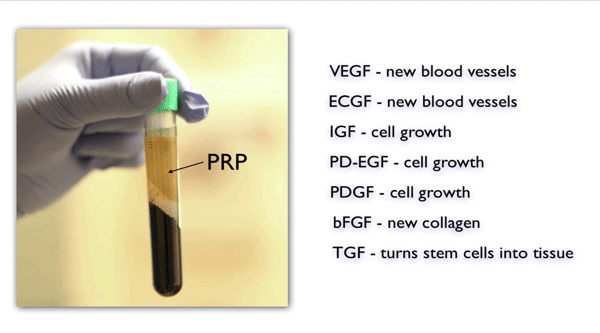Under Eye Hollows and Dark Circles Treatment
Hollowness and darkness under the eyes can be a separate or concurrent problem with puffy under eye bags. Although it seems contradictory that someone can suffer from both excess volume and a lack of volume under the eyes, in reality having them both can make each problem look worse – it’s like the valley next to a mountain next to it appears taller.
What Causes Under Eye Hollows?
Hollow under eyes, commonly referred to as tear troughs because of their depth and position in the face, is a problem suffered from a lack of volume in the under eye area. Like puffy under eye bags, it can leave people looking tired, older, and lacking energy.
While eye bags sufferers have an excess of fat under the eyes, hollowness is a lack of fat under the eyes, with thinness of lower eyelid skin also a contributing factor. Under eye hollows can be a genetic issue, and also aging related issue of the diminishment of fat and soft tissue as one gets older.

Under eye hollows is treated with a combination of a hyaluronic acid filler like Restylane for the volume deficit, and platelet-rich plasma to extend the life of the filler and improve quality of under eye skin.
How to Fix Under Eye Hollows
There are several treatment options for under eye hollows, and doctors have their preferred choices of treatment.
Tear Trough Implants
Rubber-like implants made of silicone are inserted through a small incision in the lower eyelid to give a permanent fullness under the eyes. Dr. Prasad uses the transconjunctival method for inserting and securing tear trough implants, making a small incision on the inside of the lower eyelid to position and secure the implant, so no sign of an incision or surgery is seen by anyone.
Dermal Fillers for Hollow Under Eyes
The most common treatment for under eye hollowness is the use of a cosmetic hyaluronic acid filler such as Restylane or Juvederm to restore volume under the eyes. Hyaluronic acid occurs naturally in the body, so these fillers are generally hypoallergenic.
Since cosmetic fillers are injectables, this treatment can be done by non-surgical physicians such as dermatologists. However, it is important to keep in mind that filler application is not a generic procedure, but an art.
Using the right amount of filler, and in the proper place, is where a doctor’s skill, aesthetic style, and value comes in. It is important to seek the skill of the doctor with fillers, not just base the decision on price alone. Since fillers break the skin through injection, and introduce a material into the body, Dr. Prasad approaches filler treatment as invasive procedure, and treats it like surgery, although technically it is a non-surgical procedure.
Using hyaluronic acid fillers for the lower eyelids is a much safer option than fat grafting. While fat seems to be a good choice since it is natural and part of your body, fat grafting, or fat transferring, under the eyes is highly risky procedure. Fat is unpredictable and inconsistent in texture, and may be lumpy once placed in the lower eyelids.
Thin eyelid skin may reveal the various inconsistencies and irregularities of fat under the eyes. Fat does need a blood supply, and may not take to the available blood supply of the lower eyelids. Fat is also absorbed by the body. Fat transferring/grafting is a surgical procedure, unlike injectable fillers.
Removing grafted fat from the lower eye area is also a complicated and costly procedure. While Dr. Prasad does perform fat grafts in other areas of the face where the skin is thicker such as the sub-brow and area surrounding the mouth, he does not perform or advise fat grafting under the eyelids.
Unlike tear trough implants, hyaluronic acid fillers are temporary, with the material safely absorbed by the body with time. Hyaluronic acid fillers do require periodic maintenance, from every few months to perhaps a year, depending on how fast an individual breaks it down the material.
The temporary nature of fillers can also be an advantage, as overfilling or placing the filler in the wrong place can happen with doctors who lack experience with them, or have different aesthetic style than their patients. In such cases, hyaluronic acid fillers can be dissolved using the enzyme Hyaluronidase.
Platelet-rich plasma (PRP) and hyaluronic acid filler
Dr. Prasad innovated the combination of hyaluronic acid filler with platelet-rich plasma (PRP). This unique combination actually extends the effective life of the hyaluronic acid filler, so need for periodic maintenance is also reduced.

Hollowness and pigmentation can be treated with the cosmetic filler and PRP combination. Combining the materials also extends the effective life of the filler.
Platelet-rich plasma is a material derived from the patient’s own blood. Blood is drawn like a normal blood test, then is spun in a centrifuge to concentrate and separate the plasma from the red component of the blood. Plasma is a clear, yellow serum that makes up a major part of the blood. Platelet-rich plasma is a concentration of the growth and healing factors contained in blood plasma.

Platelet-rich plasma (PRP) contains growth and healing factors that can improve the health of lower eyelid skin
Using PRP also helps treat the skin and increases blood supply to the under eye area. PRP contains several growth and healing factors that are usually used by the body to heal cuts. Placing these growth and healing factors under the eyes improves the health of thin eyelid skin, increases blood supply to the area, and triggers a collagen production response in the area. This gives the PRP treatment area a unique glow, something not experienced with any other injectable treatment.
Causes of Dark Circles Under Eyes
Puffy eye bags and hollowness under the eyes commonly have dark circles under the eyes. There are several issues that could cause dark circles:
- Pigmentation caused by genetics or sun exposure
- Pooling of blood, or collection of iron deposits from the blood in the lower eyelids
- Thin eyelid skin caused by genetics or aging to the point of translucent skin, showing anatomic elements like veins and blood vessels
- Allergies that cause swelling of blood vessels under the eyes (allergic shiners)
- Dietary issues like too much salt causing blood vessels to take on a bluish tinge
- Lifestyle choices like smoking, which can make blood vessels under the eyes appear darker
Laser for Dark Circles Under Eyes
Dark Circles Under Eyes Treatment: Regenerative Medicine to Improve the Health of Eyelid Skin
Eyelid skin is the thinnest skin in the body at about 0.5 millimeters thick. The thinnest skin coupled with the close proximity to eyeball makes this area difficult to treat, and should be left in the experienced, steady hands of an eyelid specialist.

Platelet-rich plasma (PRP) improves the health of the lower eyelids, and can be used with surgery, with cosmetic fillers, or by itself.
Dr. Prasad was an early proponent of regenerative medicine for cosmetic use. As an eyelid super-specialist and innovator, he saw the potential for platelet-rich plasma and its growth and healing factors to tackle the difficult issue of thin skin and pigmentation of the lower eyelids.
Improving lower eyelid skin with PRP’s growth and healing factors, increased blood supply, and stimulation of collagen production sets a new industry standard for treatment for the delicate and difficult under eye area. An increase in blood supply promotes better circulation, and more collagen production builds the health of delicate eyelid skin. All of these factors take dull, darkened eyes to fresher, brighter eyes with a unique glow that is unlike any other in cosmetic treatment – all uniquely done by the regenerative qualities of your own body.
If you would like to have your under eye hollows and dark circles reviewed for treatment, please fill out the contact form below, and we will get back to you. You can call us at (212) 265-8877 Manhattan, New York City office or (516) 742-4636 Garden City, Long Island office.
